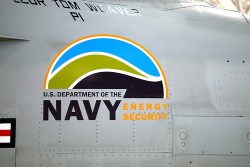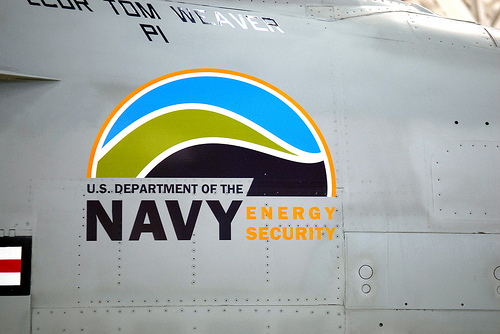
Logo on a Navy FA-18. (Photo courtesy of the USDA.)
Rep. Mike Conaway (R–Texas) hates the Navy’s biofuel program. “It’s not about proving the technology,” he told Reuters. “It’s [Navy Secretary Ray] Mabus wanting to waste money … on a publicity stunt for his green fleet.” Sen. John McCain (R–Ariz.) hates it too. “I don’t believe it’s the job of the Navy to be involved in building … new technologies. I don’t believe we can afford it.”
How does the Navy respond? Cool story, bro.
The Navy has been at the forefront of energy innovation for over a hundred years, Mabus says, transitioning from sail, to coal, to oil and then to nuclear from the 1850s to the 1950s.
“Every single time there were naysayers,” he said recently. “And every single time, every single time, those naysayers have been wrong, and they’re going to be wrong again this time.”
Earlier this month, the Navy announced a $62 million investment in biofuel technology. David Roberts has been covering this issue for a long time, noting that such investments in biofuels make an enormous amount of sense over the long term. As Mabus points out, the Navy uses 2 percent of all of the fossil fuels consumed in the United States. In 2011, the Daily Energy Report posted the breakdown of military energy consumption from 2009, below. That year, the military used 731 trillion British thermal units of oil.
Now, the Navy is bringing its focus on reducing its energy consumption onshore. Reuters reports:
The Navy unveiled a major update of its energy policies ashore on Tuesday, calling for improved efficiency, greater conservation and increased use of renewable power to cut energy consumption in half at bases worldwide by the end of the decade. …
The Navy has established a goal of cutting its power consumption in installations ashore in half by 2020. The Navy also wants half of its energy to come from renewable sources by the end of the decade, and it wants half of its installations to be net-zero consumers of energy by then. …
“I can’t overemphasize how important the culture change piece is,” [Vice Admiral Phil] Cullom said. “You’re trying to change the attitudes and the views of hundreds of thousands of people … so that what they do on board ship is what they do at home.”
If we’re to track the culture change, then, it started with Navy brass, has trickled out into the fleet, and will soon be onshore.
Give it a few more years, it might actually reach Capitol Hill.



